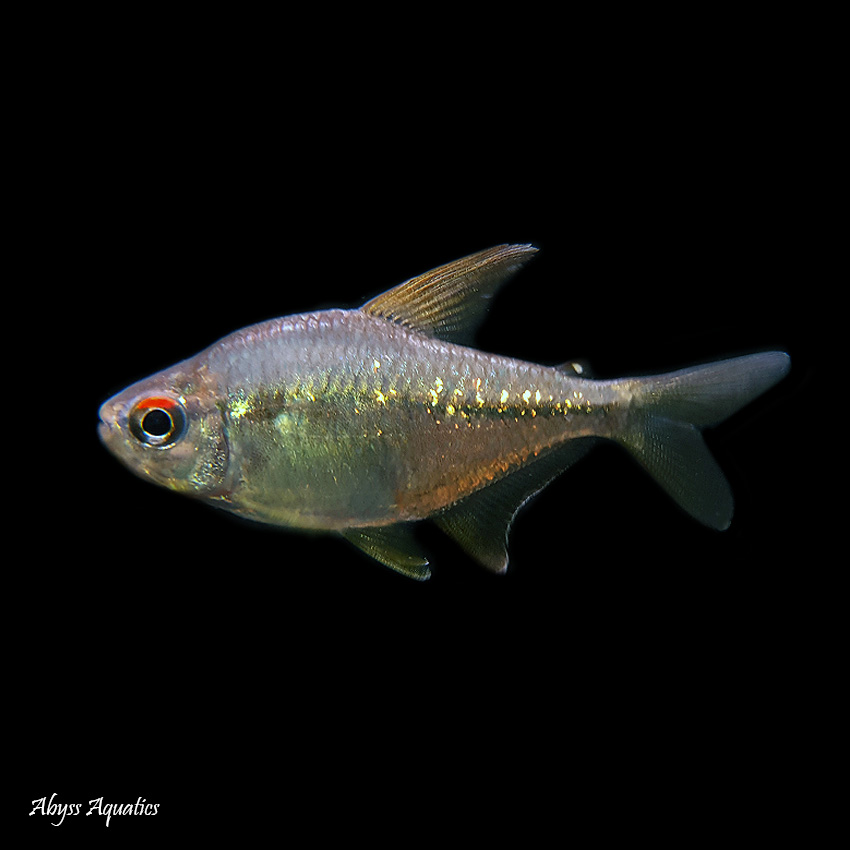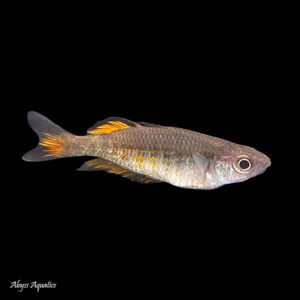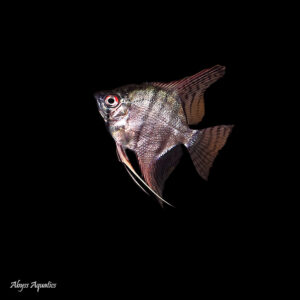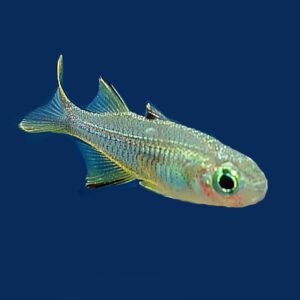The Diamond Tetra, also known as the Moenkhausia pittieri, is a small freshwater fish that is native to the streams and rivers of South America. It has a distinctive diamond-shaped iridescent patch on its body that gives it its name. The maximum size for this species is around 2.5 inches (6.5 cm) in length. The Diamond Tetra has a slender, elongated body that is slightly compressed from the sides. The coloration of the fish is mainly silver, with the diamond-shaped patch being a bright iridescent blue-green colour.
Natural Habitat
The Diamond Tetra is found in the freshwater streams and rivers of South America, particularly in the Orinoco River Basin in Venezuela and Colombia. In the wild, this species is typically found in areas with moderate to fast water flow and a mix of sand and gravel substrate. The Diamond Tetra prefers water that is well-oxygenated, with a neutral to slightly acidic pH level.
Keeping the Diamond Tetra Healthy
The Diamond Tetra is a relatively hardy fish that can be kept in a community aquarium with other peaceful fish species. They are not particularly difficult to care for, but they do have some specific requirements that should be met in order to keep them healthy. The water temperature for the Diamond Tetra should be between 72-82°F (22-28°C), and the pH level should be around 6.5-7.5. They should be kept in groups of 6 or more, as they are a schooling fish and feel more comfortable in larger numbers.
Special Requirements and Feeding
The Diamond Tetra is an omnivorous species, which means that they will eat a variety of different foods. In the wild, their diet consists of small insects, crustaceans, and other small aquatic organisms. In the aquarium, they can be fed a variety of foods, including flake, frozen, and live foods. They should be fed a high-quality flake or pellet food as their main diet, supplemented with live or frozen foods like brine shrimp or bloodworms.
How Many Diamond Tetras Should I Keep?
As previously mentioned, the Diamond Tetra is a schooling fish and should be kept in groups of 6 or more. They are a peaceful species and do well in community aquariums with other small, peaceful fish.
Lighting Preference
The Diamond Tetra is not particularly picky when it comes to lighting, but they do prefer some areas of the tank to be shaded. They should be provided with some plants or other decorations that will provide them with areas to hide.
Suitable Tank Mates
The Diamond Tetra is a peaceful fish that can be kept with other small, peaceful fish in a community aquarium. Good tank mates for the Diamond Tetra include other small tetra species, dwarf cichlids, and peaceful bottom-dwelling fish like Corydoras catfish.
Breeding Moenkhausia pittieri
Breeding Diamond Tetras can be a rewarding experience for the aquarist. Here is a guide on how to breed them successfully.
1 Setting up the Breeding Tank
To encourage Diamond Tetras to breed, it is recommended to set up a separate breeding tank. The tank should be around 10-20 gallons in size and have a pH range of 6.0-7.0. A temperature of 77-82°F (25-28°C) is ideal for breeding. Provide plenty of hiding spots for the fish, such as plants, rocks, and caves.
2 Conditioning the Fish
Before breeding, it is important to condition the male and female Diamond Tetras. Feed them a high-quality diet of live or frozen foods, such as brine shrimp, bloodworms, and daphnia. Increase the frequency and amount of feeding to encourage breeding behaviour.
3 Breeding Behaviour
Diamond Tetras are egg-scattering breeders, meaning they lay their eggs randomly throughout the tank. The male will chase the female around the tank to encourage her to release her eggs. Once the eggs are released, the male will fertilize them. The eggs will hatch within 24-36 hours.
4 Caring for the Fry
After hatching, the fry will be very small and delicate. They will need to be fed small amounts of infusoria or liquid fry food several times a day. As they grow, gradually introduce more substantial foods, such as newly hatched brine shrimp or crushed flakes.
5 Separating the Fry
Once the fry are free-swimming, it is recommended to separate them from the adult fish to prevent them from being eaten. You can use a fine mesh net to scoop the fry out of the breeding tank and transfer them to a separate rearing tank. The rearing tank should be kept at the same water parameters as the breeding tank.
6 Conclusion
Breeding Diamond Tetras can be a challenging but rewarding experience. With proper conditioning and care, you can successfully breed these beautiful fish in your home aquarium.
Sexual Dimorphism
Male and female Diamond Tetras can be difficult to tell apart, but females tend to be slightly larger and have a rounder belly than males.
Distribution
The Diamond Tetra is native to the streams and rivers of South America, particularly in the Orinoco River Basin in Venezuela and Colombia. Some strains
Distribution: The Diamond Tetra is native to the Amazon River Basin in South America, specifically in the countries of Brazil, Peru, and Colombia. It can also be found in other areas of South America due to human introduction. Some Diamond Tetras available in the aquarium trade may be captive-bred, but the wild type originates from the Amazon River and its tributaries.
Summary
Overall, the Diamond Tetra is a peaceful and colourful fish that is great for beginners and experienced aquarists alike. While they do require some specific water parameters and a varied diet, with proper care they can thrive in a well-maintained aquarium. Their stunning appearance, social behaviour, and ease of care make them a popular choice for many hobbyists.
Additionally, the Diamond Tetra is a fish with an interesting history. They were once incredibly hard to obtain in the aquarium hobby, as they were not commonly imported into the trade. A Dutch aquarist named Kees de Jong I think, was one of the few people who successfully bred them in captivity, and for years he was the only source of Diamond Tetras for aquarists around the world. However, as they became more popular, more breeders started to produce them, and they are now widely available in the hobby.
At Abyss Aquatics, the Diamond Tetra is one of our favorite fish due to its striking appearance and peaceful nature. We only sell tank-bred specimens, which are generally healthier and more resilient than wild-caught specimens. These fish are a great addition to any community aquarium and their unique appearance is sure to make them a standout in your tank.





iwona semaine (verified owner) –
Lovely new little diamonds happily settled in my angelfish community tank. They literally bring the tank to life. I am very pleased with the whole process of ordering from Abyss and very happy with the quality of fish and fantastic plants on offer. Will be back for more soon.